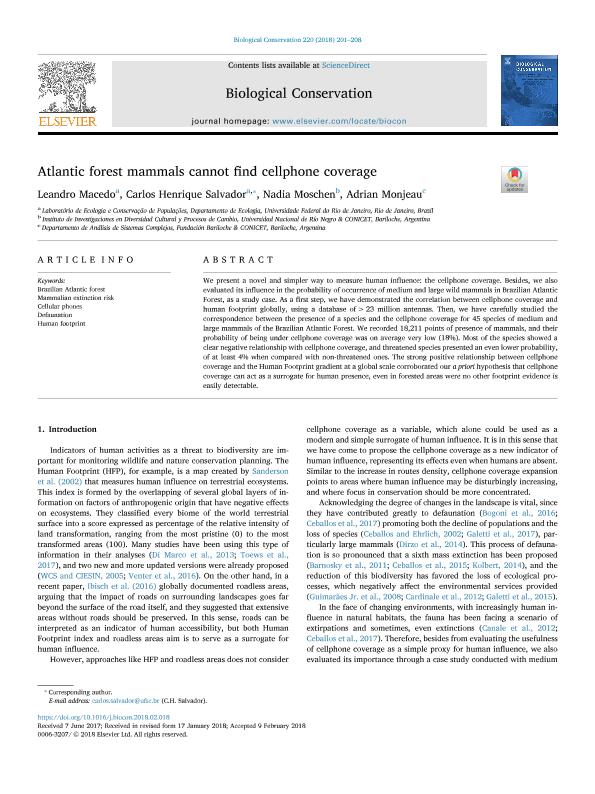Mostrar el registro sencillo del ítem
dc.contributor.author
Macedo, Leandro
dc.contributor.author
Salvador, Carlos Henrique
dc.contributor.author
Moschen, Nadia Leticia

dc.contributor.author
Monjeau, Jorge Adrian

dc.date.available
2021-01-06T12:21:35Z
dc.date.issued
2018-04
dc.identifier.citation
Macedo, Leandro; Salvador, Carlos Henrique; Moschen, Nadia Leticia; Monjeau, Jorge Adrian; Atlantic forest mammals cannot find cellphone coverage; Elsevier; Biological Conservation; 220; 4-2018; 201-208
dc.identifier.issn
0006-3207
dc.identifier.uri
http://hdl.handle.net/11336/121571
dc.description.abstract
We present a novel and simpler way to measure human influence: the cellphone coverage. Besides, we also evaluated its influence in the probability of occurrence of medium and large wild mammals in Brazilian Atlantic Forest, as a study case. As a first step, we have demonstrated the correlation between cellphone coverage and human footprint globally, using a database of>23 million antennas. Then, we have carefully studied the correspondence between the presence of a species and the cellphone coverage for 45 species of medium andlarge mammals of the Brazilian Atlantic Forest. We recorded 18,211 points of presence of mammals, and their probability of being under cellphone coverage was on average very low (18%). Most of the species showed a clear negative relationship with cellphone coverage, and threatened species presented an even lower probability, of at least 4% when compared with non-threatened ones. The strong positive relationship between cellphone coverage and the Human Footprint gradient at a global scale corroborated our a priori hypothesis that cellphonecoverage can act as a surrogate for human presence, even in forested areas were no other footprint evidence is easily detectable.
dc.format
application/pdf
dc.language.iso
spa
dc.publisher
Elsevier

dc.rights
info:eu-repo/semantics/openAccess
dc.rights.uri
https://creativecommons.org/licenses/by-nc-sa/2.5/ar/
dc.subject
BRAZILIAN ATLANTIC FOREST
dc.subject
MAMMAL EXTINCTION RISK
dc.subject
CELLULAR PHONES
dc.subject
DEFAUNATION
dc.subject.classification
Conservación de la Biodiversidad

dc.subject.classification
Ciencias Biológicas

dc.subject.classification
CIENCIAS NATURALES Y EXACTAS

dc.title
Atlantic forest mammals cannot find cellphone coverage
dc.type
info:eu-repo/semantics/article
dc.type
info:ar-repo/semantics/artículo
dc.type
info:eu-repo/semantics/publishedVersion
dc.date.updated
2020-11-18T20:45:44Z
dc.journal.volume
220
dc.journal.pagination
201-208
dc.journal.pais
Países Bajos

dc.journal.ciudad
Amsterdam
dc.description.fil
Fil: Macedo, Leandro. Universidade Federal do Rio de Janeiro; Brasil
dc.description.fil
Fil: Salvador, Carlos Henrique. Universidade Federal do Rio de Janeiro; Brasil
dc.description.fil
Fil: Moschen, Nadia Leticia. Consejo Nacional de Investigaciones Científicas y Técnicas. Centro Científico Tecnológico Conicet - Patagonia Norte. Instituto de Investigaciones en Diversidad Cultural y Procesos de Cambio. Universidad Nacional de Río Negro. Instituto de Investigaciones en Diversidad Cultural y Procesos de Cambio; Argentina
dc.description.fil
Fil: Monjeau, Jorge Adrian. Consejo Nacional de Investigaciones Científicas y Técnicas; Argentina. Fundación Bariloche; Argentina
dc.journal.title
Biological Conservation

dc.relation.alternativeid
info:eu-repo/semantics/altIdentifier/url/https://www.sciencedirect.com/science/article/abs/pii/S0006320717310212?via%3Dihub
dc.relation.alternativeid
info:eu-repo/semantics/altIdentifier/doi/https://doi.org/10.1016/j.biocon.2018.02.018
Archivos asociados
